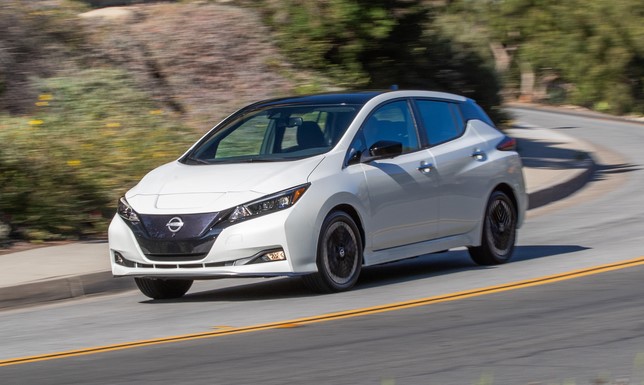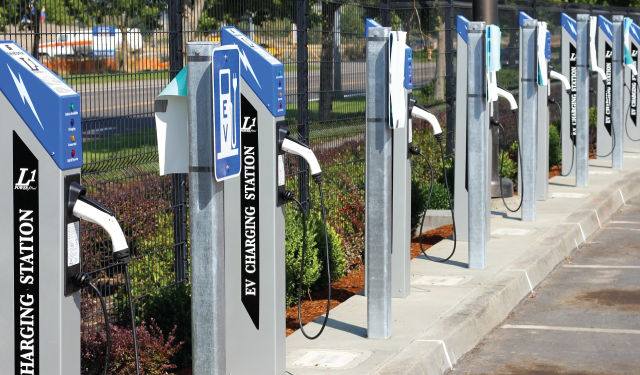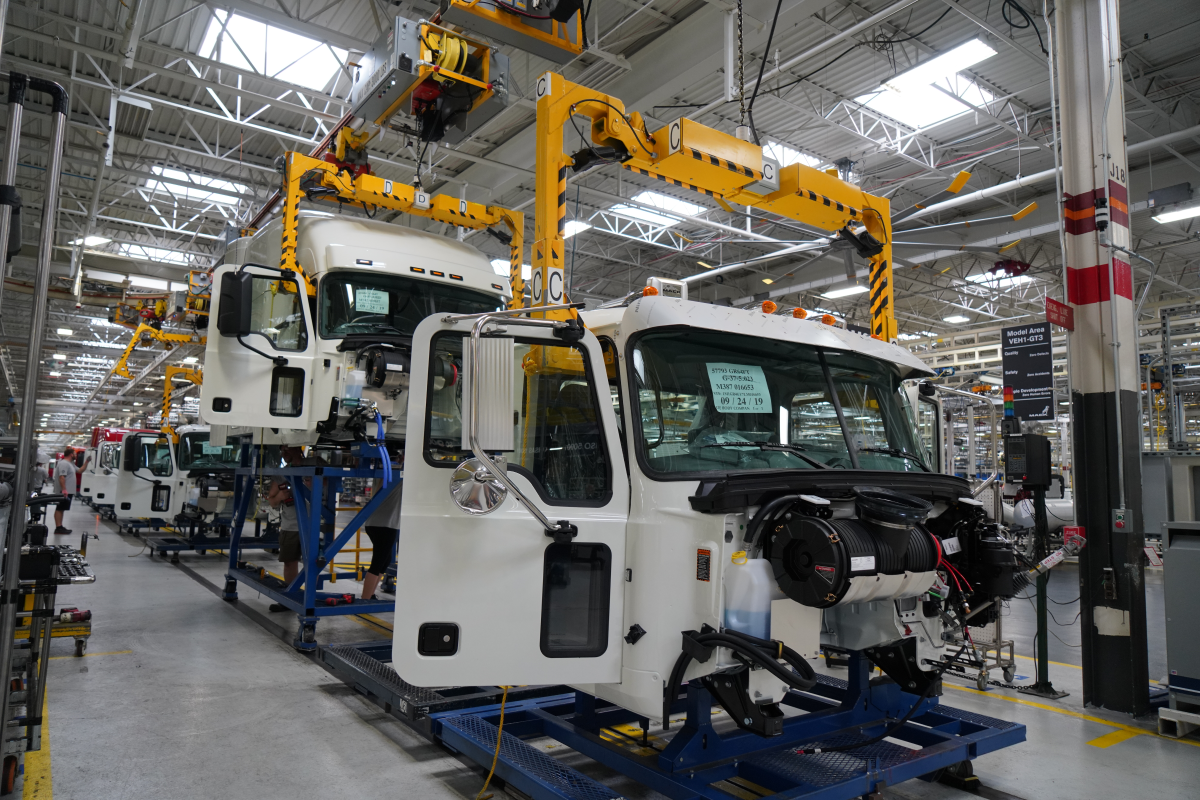Federal Policy
Home > Our Work > Federal EV Policy > Inflation Reduction Act Impacts on Electric Vehicles
Inflation Reduction Act Impact on Electric Vehicles
The Inflation Reduction Act of 2022 is perhaps the most significant legislation to accelerate transportation electrification in U.S. history. The Electrification Coalition (EC) has been advocating for many of the key measures included in the law for over a decade. Altogether, this is a major win for consumers and businesses, but there are challenges on the road ahead.
The Inflation Reduction Act is now one year old and is spurring private investments and American jobs. Learn more on Inflation Reduction Act at One Year.
Check out our EV Funding Finder to identify transportation electrification funding opportunities made available by federal legislation.
Watch a webinar on recent EV legislation by the Electrification Coalition and SAFE.
Table of Contents
Light-duty EV Tax Credit
 The light-duty electric vehicle (EV) tax credit of up to $7,500 per vehicle has been extended through 2032, which will allow millions more consumers to utilize this credit. The previous credit, with a cap of 200,000 vehicles per automaker, had already ended for Tesla and General Motors and would have soon ended for other automakers. However, other modifications, including an MSRP cap, income cap, assembly/sourcing requirements, and options to transfer the credit to a dealer at the point of sale, have been added. Some of these requirements will be phased in over the next few years.
The light-duty electric vehicle (EV) tax credit of up to $7,500 per vehicle has been extended through 2032, which will allow millions more consumers to utilize this credit. The previous credit, with a cap of 200,000 vehicles per automaker, had already ended for Tesla and General Motors and would have soon ended for other automakers. However, other modifications, including an MSRP cap, income cap, assembly/sourcing requirements, and options to transfer the credit to a dealer at the point of sale, have been added. Some of these requirements will be phased in over the next few years.
- For a full breakdown of the changes to the light-duty EV tax credit, view a factsheet created by the EC and SAFE.
- One provision that takes effect immediately is a requirement that a vehicle’s final assembly take place in North America. Visit the Alternative Fuels Data Center for a list of which vehicles may be eligible for the credit.
- As of December 31, 2022, requirements on critical minerals and battery components have been implemented, as outlined in our factsheet. While the EC would have preferred a more gradual phase-in of these requirements and more countries added to the minerals and battery components lists, the provision encourages the diversification of supply chains.
- Also, beginning in 2023, MSRP and income caps have taken effect. Beginning in 2024, taxpayers can transfer their tax credit to dealers, enabling them to receive the credit as a rebate at the point of sale. For more information, view our factsheet.
Used EV Tax Credit
For the first time, used EVs will be eligible for federal tax credits of up to $4,000 or 30% of the sales price, whichever is lower. The sales price must be less than $25,000 and the vehicle must be at least two years old. Income caps also apply. View our factsheet for more information.
Commercial EV Tax Credit
Commercial EVs will also be eligible for federal tax credits for the first time ever, up to 30% of the sales price. For more information, view our factsheet.
As of December 2022, the 45W credit extends to commercial and tax-exempt entities, making government entities eligible to claim the credit. The credit is up to $7,500 for vehicles under 14,000 pounds and up to $40,000 for all other vehicles. Only certain vehicles are eligible for the credit, as the new law stipulates certain manufacturing and final assembly requirements. The Alternative Fuels Data Center for the U.S. Department of Energy has created a tool to determine vehicle eligibility.
Governments will receive the credit as a direct payment, as they typically do not pay taxes. The entity will elect to receive the compensation on a tax filing. The IRS is still in the process of releasing further guidance on how the payment will work. Similarly, the IRS is finalizing the forms to claim the credits, so check back here or on the IRS page to learn more as information comes out.
EV Charging Equipment Tax Credit
 The federal tax credit on charging equipment has been extended through 2032. For individual/residential uses, the tax credit remains unchanged at 30%, up to $1,000. For commercial uses, the tax credit Is 6% with a maximum credit of $100,000 per unit (up from $30,000 per property). The equipment must be placed in a low-income community or non-urban area.
The federal tax credit on charging equipment has been extended through 2032. For individual/residential uses, the tax credit remains unchanged at 30%, up to $1,000. For commercial uses, the tax credit Is 6% with a maximum credit of $100,000 per unit (up from $30,000 per property). The equipment must be placed in a low-income community or non-urban area.
- Low-income communities include population census tracts where (a) the poverty rate is at least 20 percent or (b):
- for a tract outside a metropolitan area, the median family income does not exceed 80% of statewide median family income, or
- for a tract within a metropolitan area, the median family income does not exceed 80% of the greater of statewide median family income or the metropolitan area median family income.
Electrifying the USPS Fleet
The law allocates $3 billion for electrifying the United States Postal Service fleet, including vehicles and charging infrastructure, which the EC has strongly advocated for.
Clean Heavy-duty Vehicles
The law allocates $1 billion to states, municipalities, Indian tribes, or non-profit school transportation associations to replace class 6 and 7 heavy-duty vehicles with clean EVs. These rebates can be used for up to 100% of the costs for vehicles, infrastructure, training, and planning and technical activities to support electrification.
Other Key Provisions
 Several other key measures in the law, including support for EV manufacturing and supply chains, include:
Several other key measures in the law, including support for EV manufacturing and supply chains, include:
- $60 million for the Diesel Emission Reduction Act program,
- $2 billion for the Domestic Manufacturing Conversion Grant program,
- $3 billion for the Advanced Technology Vehicle Manufacturing program,
- A long-term extension of the Advanced Manufacturing Production Credit,
- $2.25 billion to reduce air pollution at ports through deploying zero-emission technology,
- A strong Environmental and Climate Justice Block Grant program,
- And a strong Greenhouse Gas Reduction Fund.
Frequently Asked Questions
Does this legislation kill the federal EV tax credit?
No. The tax credit as it previously existed had already ended for some of the most popular EV models and would soon end for models from a few other automakers. While some of the requirements in the new tax credit will lead to challenges in the coming years, extending the tax credit for another decade, through 2032, will ensure the long-term growth of the EV market in the U.S. Additionally, the incentives included in the law for manufacturing and supply chains will help automakers meet the new requirements.
What if I purchased an electric vehicle between January 1 and August 16, 2022?
Vehicles purchased before the Inflation Reduction Act was signed into law are still eligible for the previous tax credit. If you have a written contract to purchase a vehicle before August 16, but have not received it yet, you are still eligible to receive the previous credit as long as you “place it in service.”
What if I purchase an electric vehicle between August 17 and December 31, 2022?
The only change in the federal tax credit that takes place immediately is the requirement that the vehicle’s final assembly take place in North America. Other requirements, including those related to critical minerals and battery components, do not begin until the IRS guidance is complete for those sections, no later than December 31, 2022, and are phased in over the next few years.
How do I know if my vehicle is eligible for the federal tax credit?
Effective immediately, vehicles’ final assembly must be in North America to be eligible for the federal tax credit. While information is still being obtained, visit the Alternative Fuels Data Center for the most up-to-date information on which vehicles may be eligible for the tax credit. Requirements on critical minerals and battery components do not take effect until the IRS guidance on those sections is complete, no later than December 31, 2022.
Beginning in 2024, taxpayers can transfer their credit to a dealer to receive it at the point of sale, but what about vehicles bought directly from a manufacturer?
The text does not say that the seller must be a franchised dealer and only says that the seller must be licensed to sell vehicles in a state, though not necessarily the state where the sale takes place. The taxpayer should be able to transfer the credit to the automaker selling the vehicle, even if it is not a franchised dealer, though the IRS guidance on this section will provide further clarity. Additionally, the taxpayer can also simply take the credit on their taxes and not transfer the credit.
This information is provided as guidance, based on our interpretation of the Inflation Reduction Act, but we recommend that you consult your tax advisor for specific questions regarding your situation.
Additional Resources
We invite you to check out these additional resources:
- Inflation Reduction Act: Clean Energy Project Eligibility for Local Governments – National League of Cities (nlc.org)
- How Local Governments Can Use Direct Pay on Clean Energy Projects – National League of Cities (nlc.org)
- Manufacturers and Models for New Qualified Clean Vehicles Purchased in 2023 or After | Internal Revenue Service (irs.gov)
- Commercial Clean Vehicle Credit | Internal Revenue Service (irs.gov)
- Frequently Asked Questions on the Inflation Reduction Act’s Initial Changes to the Electric Vehicle Tax Credit (treasury.gov)
